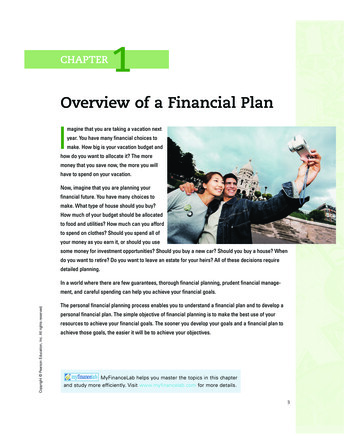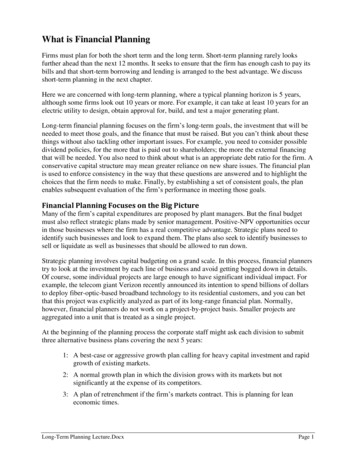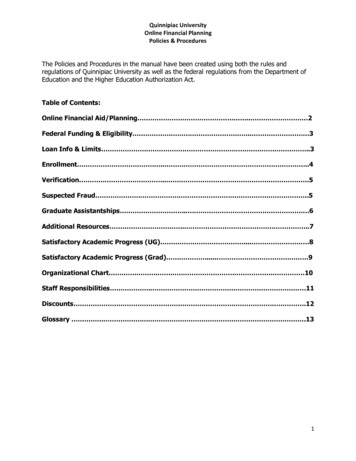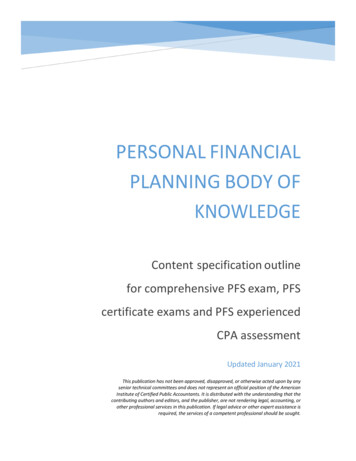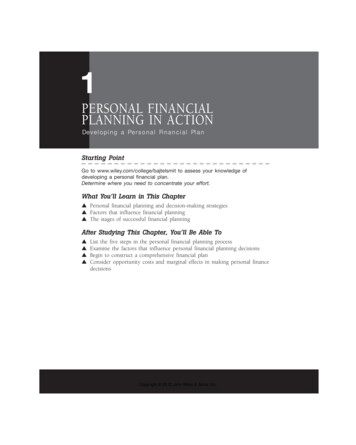
Transcription
c01.qxd4/26/122:30 PMPage 11PERSONAL FINANCIALPLANNING IN ACTIONDeveloping a Personal Financial PlanStarting PointGo to www.wiley.com/college/bajtelsmit to assess your knowledge ofdeveloping a personal financial plan.Determine where you need to concentrate your effort.What You’ll Learn in This Chapter Personal financial planning and decision-making strategies Factors that influence financial planning The stages of successful financial planningAfter Studying This Chapter, You’ll Be Able To List the five steps in the personal financial planning processExamine the factors that influence personal financial planning decisionsBegin to construct a comprehensive financial planConsider opportunity costs and marginal effects in making personal financedecisionsCopyright 2012 John Wiley & Sons, Inc.
c01.qxd4/26/1222:30 PMPage 2PERSONAL FINANCIAL PLANNING IN ACTIONINTRODUCTIONKnowing how to manage your finances can help you be more successful in life.In this chapter, we first look at the five-step financial planning process and thenthe factors that influence it, and we discuss the elements of a comprehensive financial plan. Finally, we explore strategies for making effective financial decisions.With this framework, you will be able to gain the tools for successful personalfinancial management.1.1 The Personal Financial Planning ProcessIn your life, you’ve probably already faced some financial challenges. For example,maybe you’ve asked yourself one or more of the following questions: Should I take out a student loan to pay for college expenses?How can I get out from under my credit card debt?Can I afford to replace my car’s transmission?Where should I buy my auto insurance?Would graduate school be a good investment for me?How much should I contribute to my 401(k) retirement plan?Should I start a savings plan to fund my child’s college education?How do I decide among the employee benefit options that my employeroffers?These questions are all related to personal finance—a specialized area of study thatfocuses on individual and household financial decisions, such as budgeting, saving,spending, insurance, and investments. Understanding these topics will help you inmany ways. For example, you’ll make better decisions when you buy an auto, shopfor a home mortgage, choose a career, and save for retirement. You may also be ableto pay less in taxes and interest. Personal financial planning is the process of developing and implementing an integrated, comprehensive plan designed to meet financial goals, to improve financial well-being, and to prepare for financial emergencies.The primary goal of personal financial planning is to develop and achievefinancial goals, such as Buying a first home or a bigger home.Making a major consumer purchase.Supporting a growing family.Preparing financially for retirement.People who have their finances in order gain important social and psychologicalbenefits as well. Generally, they feel less stressed and experience improvedCopyright 2012 John Wiley & Sons, Inc.
c01.qxd4/26/122:30 PMPage 31.1 THE PERSONAL FINANCIAL PLANNING PROCESSFigure 1-1Step 1. rentryour cuezylAnaes.financStep 2.Develop goals.Step 3.Identify and evaluatestrategies to achieveyour goals.StepEstabl 4.iimplem sh andent yourplan.Step 5.Reevaluate and revise your plan as needed.The five-step financial planning process.relationships with friends, family members, and coworkers. As many couplesknow, financial difficulties are a major contributor to marital problems. Most people also find that the self-sufficiency that eventually results from good financialplanning improves their self-esteem.In this section, we introduce the five-step personal financial planning process(see Figure 1-1) and examine each step in detail. It’s important as you read aboutthe steps to recognize the circular flow of the planning process. Although youuse the process to develop a personal financial plan, your plan won’t ever be afinished product; you’ll need to reevaluate and revise it continually as your lifecircumstances change. The process of personal financial planning is a lifelongactivity.1.1.1 Step 1: Analyze Your Current Financial PositionAt the end of the month, many people struggle to meet their expenses. “Wheredid all the money go?” is a common lament. Before you can move forward withyour financial plan, you need to determine where your money is coming fromand where it is going.Analyzing your current financial position requires that you take the followingsteps:1. Collect and organize all your financial information.2. Create personal financial statements.3. Quantitatively evaluate your current financial position to establish a baseline against which you can measure improvement in the future.This last step may involve hard work for those who are “organizationallychallenged.” Nevertheless, careful record keeping is vital to good financialplanning, because it enables you to track actual expenditures and identifyCopyright 2012 John Wiley & Sons, Inc.3
c01.qxd4/26/1242:30 PMPage 4PERSONAL FINANCIAL PLANNING IN ACTIONsmall financial problems before they turn into big ones. In Chapter 2, weexplain how to analyze your current finances to determine your financialcondition.1.1.2 Step 2: Develop Short-Term and Long-Term Financial GoalsEveryone has a personal conception of “success.” Have you thought aboutwhere you want to be 5 years from now? 10 years from now? For some, success may be defined in monetary terms and for others, in levels of personalsatisfaction. However you define success, the second step in the personal financial planning process requires that you identify and prioritize specific goals andobjectives.The process of setting goals should involve some introspective assessment ofwhy you have the goals you have. For example, are your objectives focused onyour own needs or the needs of others? Are your objectives related to pressuresfrom family members or peers?Keep in mind that short-term and long-term goals change over time and maybe influenced by changes in economic circumstances.1.1.3 Step 3: Identify and Evaluate Alternative Strategiesfor Achieving Your GoalsAlthough every person’s goals and objectives are unique to his or her circumstances, the strategies for achieving them are similar from person to person. Ingeneral, in order to have more money available to meet current or future goals,you either have to reduce spending or increase earnings. Step 3 in the personalfinancial planning process requires that you identify alternative strategies forachieving goals and compare the costs and benefits of each.1.1.4 Step 4: Implement a Plan for Achieving Your GoalsUsing the information developed in step 3, you are now prepared to decideon the best strategies for achieving your goals so that you can implement yourplan. How do you make such decisions? How do you know which strategiesare the best ones for achieving your goals? You acquire fundamental knowledge and master analytical tools that help you to make effective personal financial planning decisions. The result will be a personal financial plan that meetsyour basic household needs, builds wealth over time, and protects your incomeand assets.1.1.5 Step 5: Regularly Reevaluate and Revise Your PlanMany changes occur over the course of your life. Not only do changes in yourpersonal circumstances (e.g., graduation, a new job, marriage, children) affectCopyright 2012 John Wiley & Sons, Inc.
c01.qxd4/26/122:30 PMPage 51.1 THE PERSONAL FINANCIAL PLANNING PROCESSFOR EXAMPLEWhen Goals Must ChangeIn 2006, Jack Naughton was employed as a superintendent for a large residential construction firm. He and his wife lived comfortably on his 50,000salary and felt lucky that he had been able to work his way up in the business, despite his lack of a college degree. They had recently stretched theirfinances to buy a larger house, and they planned to increase their retirementaccount contributions and to begin a college savings plan for their daughter.Due to a real estate downturn, Jack was unexpectedly laid off from hisjob, and the Naughtons’ goals had to change drastically. Instead of retirementand college savings, their new goals were to pay their bills and find a new jobfor Jack. After his layoff, Jack found a new job but had to take a significantpay cut, and his earnings no longer covered the family’s expenses. To meetexpenses, the Naughtons might use one or more of the following strategies: Mrs. Naughton could get a job. They could sell the house or possibly refinance it at a lower interest rate to reduce their monthly mortgage payments. They could sell other assets. They could dip into savings. They could borrow money.Each of these strategies has costs and benefits that must be carefully identified and evaluated.your financial planning objectives and strategies, but economic conditions maynecessitate revision of the plan as well. An effective financial plan must be adaptable to changing circumstances. Thus, step 5 takes you continually back to steps 1through 4.SELF-CHECK1. Define personal finance and personal financial planning.2. List the five steps of the personal financial planning process.Copyright 2012 John Wiley & Sons, Inc.5
c01.qxd4/26/1262:30 PMPage 6PERSONAL FINANCIAL PLANNING IN ACTION1.2 Factors That Influence Personal Financial PlanningAs you build your financial plan, you need to consider many factors that influence your spending and saving behavior. Some are unique to you, such as whereyou are in your life cycle, your family composition, your values, and yourattitudes. Others, such as inflation and interest rates, affect everyone to someextent. Both types of factors can be expected to change over time, so your planneeds to continually adapt to new circumstances.1.2.1 Changing Needs over the Life CycleYour household goes through several phases over your life cycle, and your financial situation changes as well. Figure 1-2 illustrates how a person’s income andwealth might change over the life cycle. There are many different types of familysituations. Although everyone’s situation is unique, for everyone, there aresignificant differences in planning needs over the life cycle.In general, your income level through your early 20s is lower than it is later,and your wealth may even be negative—that is, you may have more debts thanassets at this point in your life. That’s because you’re making investments in youreducation that have not yet paid off.Marriage, career development, the purchase of a home, and investments inyour children’s education will likely occur from your late 20s through your 40s.Figure 1-21,000,000Household wealth800,000600,000400,000200,0000Household income 200,0000153045Age60Household income and wealth over the life cycle.Copyright 2012 John Wiley & Sons, Inc.7590
c01.qxd4/26/122:30 PMPage 71.2 FACTORS THAT INFLUENCE PERSONAL FINANCIAL PLANNINGDuring this time, your household will focus on setting goals, establishing savings,and protecting the family against unexpected negative events, such as prematuredeath or job loss due to illness or disability. This is also the beginning of thewealth accumulation phase, which continues through your 50s to early 60s.As retirement approaches, most people in their 50s and 60s pay closer attention to meeting retirement income and health needs and preserving wealth fortheir heirs. The earlier you plan for these needs, the better off you are when youget to that stage in the life cycle. During your retirement period, which generallybegins at age 65, you decumulate, or spend, your accumulated wealth. Your goalsduring retirement may include maintaining an active lifestyle, including travel andleisure activities, and having sufficient income throughout your retirement period.1.2.2 Values and AttitudesPeople have different money styles—different values and attitudes regarding moneyand its use. A person’s money style is generally the result of both learned behaviors and inherent tendencies. For example, if you were raised in a household wheremoney was tight and consumer purchases were made with careful deliberation,you might carry the money skills learned from your parents’ example into youradult life.Whether your parents were spendthrifts or tightwads, however, your owngenetic makeup also affects your personal money style. Individuals who areimpulsive by nature often have difficulty controlling their spending, just as thosewith a tendency to orderliness are more likely to have their finances in order.Thus, both nature and nurture help to form your values and attitudes towardmoney. In fact, it is not uncommon to find that siblings raised in the same households have very different money styles. We explain here what we mean by valuesand attitudes: Values are fundamental beliefs about what is important in life. What doyou think is most important: family, friends, things, education, religiousfaith, financial success, fame, health, self-sufficiency? The weight youplace on each influences the goals you set and the strategies you developto achieve your goals. Attitudes are opinions and psychological differences between people thataffect their decisions. Are you an optimist or a pessimist? conservative orliberal? Do you like to have everything planned out in advance or just gowith the flow?Of particular importance to financial planning is your attitude toward risk, oruncertainty: Are you a risk-taker, or do you tend to avoid risk? What if youalready know that you have a problem with money? Is it possible to overcomeyour biological makeup and your learned values and attitudes? Of course! Youmust first recognize what your values and attitudes are, particularly where theyCopyright 2012 John Wiley & Sons, Inc.7
c01.qxd4/26/1282:30 PMPage 8PERSONAL FINANCIAL PLANNING IN ACTIONmay run counter to achieving your goals. If you are a spender, you may needto approach your budget differently than someone who is naturally inclined tobe more conservative in spending. Similarly, if you are a natural risk taker, youmay need to learn to be more cautious, like someone who tends to avoid risk.1.2.3 Life SituationFamily composition and demographic characteristics—such as age, marital status, income, and wealth—significantly affect financial planning. Households withchildren, for example, tend to have higher expenses and therefore less ability tosave during their child-rearing years.Children’s college expenses can take a big bite out of family savings. Doubleincome couples, particularly those with no children, tend to be better off financiallythan singles. Those without children are also more able to focus on career goalsand therefore can more quickly move up the employment ladder. However, thefinancial and social support provided by children to their parents in old age mayeventually offset the increased earlier costs.Also, education plays a critical role in financial success. College-educatedpeople, particularly those with specialized skills (e.g., business, education, engineering), tend to receive higher starting salaries and larger wage increases overtheir careers. White-collar employees are also more likely to receive retirementplans and benefits packages.Demographic factors such as gender, age, income, and education have alsooften been linked to risk attitudes. If you are male, childless, educated, and highincome you are more likely to be a risk taker.1.2.4 Economic Factors that are Important to Financial PlanningA fundamental truth about the economy is that it is very unpredictable. Even theexperts, such as Ben Bernanke, Chairman of the Federal Reserve, cannot say withcertainty what the future may hold. Nevertheless, some factors in the economyhave a known influence on personal finances, and it’s important for you to recognize these factors and incorporate them in your financial planning decisions.Beginning in mid-2007, the global economy began to experience seriousfinancial problems, leading to what many people now call the “Global FinancialCrisis” or the “Great Recession.” The U.S. economy was hurt by rising housingprices, poor business performance, and high unemployment, problems that persisted through 2011. Despite record low interest rates, businesses and households have had difficulty obtaining credit as lenders continued to apply veryrestrictive lending standards to reduce their risk.Throughout this course, you’ll be developing your knowledge related to economic factors that affect financial planning. Some factors that are highly likelyto affect your future are inflation, interest rates, employment conditions, political unrest, and global issues. We’ll discuss each of these in this section.Copyright 2012 John Wiley & Sons, Inc.
c01.qxd4/26/122:30 PMPage 91.2 FACTORS THAT INFLUENCE PERSONAL FINANCIAL PLANNINGInflationEveryone has at one time or another heard an older person say, “When I was akid, it was a lot less expensive to. . . .” Such statements describe the effects ofinflation, the change in general price levels over time. Occasionally, there canbe a negative inflation rate—that is, the prices of goods and services actuallydecline over a given period. Generally, however, inflation refers to an increase inprices, like the inflating of a balloon. As prices of goods and services go up, thespending power of your money goes down—a dollar will not purchase as muchas it previously did.Inflation affects nearly every aspect of your finances. Your grocery bills areprobably higher this year than they were last year. You’re paying more for gasoline than in the past. Your monthly rent will probably go up next year, too. Asprices of goods get higher over time, you can only maintain your standard ofliving if your income also increases at a similar rate. For your standard of livingto improve, your income must increase at a greater rate than the inflation rate.Inflation affects your investments as well. If the costs of goods rise at a rate of4 percent, but your savings account is only paying you 3 percent, then you areactually losing spending power.For the overall U.S. market, inflation is measured by the change in the consumer price index (CPI), reported monthly by the Bureau of LaborStatistics. The CPI tracks prices of a representative basket of more than 400 goodsand services used by urban households, including food, housing, consumer goods,gasoline, and clothing. Figure 1-3 illustrates the changing costs of various goodsFigure 1-3YearMedianHouseholdIncomeGallonof GasLoaf ofWhiteBreadDozenGrade AEggsTuition,Fees, Room& 6,150% Increase1980 to 2010Annul ewFordMustang2,37221,395Sources: U.S. Department of Education, National Center for Education Statistics, www.nces.gov, and AnnualSurvey of College; Income and price data from the Bureau of Labor Statistics, www.bls.gov.Changes in Income and Prices over Time.Copyright 2012 John Wiley & Sons, Inc.9
c01.qxd4/26/12102:30 PMPage 10PERSONAL FINANCIAL PLANNING IN ACTIONand services over the last 30 years. The price of eggs has approximately doubledsince 1980, but the cost of a college education at a public four year institution hasskyrocketed. Although the table only shows a modest change in gasoline costs overthe last three decades, the biggest increases have occurred in the last few years,causing serious problems for many household budgets.Depending on various factors, you may experience a larger or smaller changein expenses than the price changes indicated by the CPI. For example, someareas of the country have higher rates of inflation than average, primarily becauseof higher fuel and housing costs. Housing in areas of the country that are inhigh demand can be extremely costly.You will also have different demands for goods and services at different stagesin the life cycle. For example, health-care costs, which have risen at a muchfaster rate than other elements of the CPI, are a bigger component of a retiree’sexpenses. Housing costs, in contrast, have less importance for retirees, sincemany retirees have paid off their home mortgages. Furthermore, inflation can beparticularly problematic for people on fixed incomes. If your retirement incomedoesn’t increase over time, but your expenses do, your standard of living willgradually decline.The CPI in January 2011 was 220.22, which represented an increase fromthe January 2010 CPI of 216.69. Normally, when people talk about inflation, theyare actually talking about the percentage change in the index. To calculate the percentage increase over a period of time, you can use either of the following equations to arrive at the same answer.Percentage change OR New value Old ValueOld ValueNew Value 1Old ValueSo, we can calculate inflation between 2010 and 2011 as follows:(220.22-216.69)/216.69 0.016 or 1.6 percent.If you’re looking at changes over several years, you may also want to convert the percentage change to annual percentage change for the time period:Annual Percentage Change (1 Percentage Change)1/N 1Where N Number of YearsBeing able to calculate percentage change is useful not only for the inflationcalculation but also for calculating percentage increases in your salary and investments over time. The For Example feature “Calculation of Percentage Change”gives you an opportunity to try this out for estimating salary increases.Copyright 2012 John Wiley & Sons, Inc.
c01.qxd4/26/122:30 PMPage 111.2 FACTORS THAT INFLUENCE PERSONAL FINANCIAL PLANNINGFOR EXAMPLECalculation of Percentage ChangeYour salary in Year 1 was 24,000 and in Year 2, it increased to 25,000.Your new salary for Year 3 is 27,500.What was the annual percentage increase in your salary between Years2 and 3?StrategyRecall that the total increase over a period can be calculated as:Percentage change ORNew value Old ValueOld ValueNew Value 1Old ValueSolutionThe percentage increase in your salary based on your new raise is:Percentage change 27,500 – 25,000 0.1 or 10%25,000What was the annual percentage increase in your salary between Years1 and 3?StrategyYou first need to calculate the percentage change over the two year period.Then you can calculate the annual percentage change as follows:Annual Percentage Change (1 Percentage Change)1/N 1Where N Number of YearsSolutionYour salary two years ago was 24,000. Your new salary (two years later) is 27,500. The percentage change over the two year period is:Percentage Change 27,500 – 24,000 0.1458 or 14.58%24,000(Continued)Copyright 2012 John Wiley & Sons, Inc.11
c01.qxd4/26/12122:30 PMPage 12PERSONAL FINANCIAL PLANNING IN ACTIONNext, you can calculate the annual change as:Annual Percentage Change (1 0.1458)1/2 1 1.0704 1 .0704 or 7.04%Note that, as an approximation, you can take individual annual changesand average them, but for longer time periods, this will be very time-consuming and will not be as accurate. (Note: Most calculators will allow youto raise a number to any power using a key labeled yx. Enter the numberyou want to raise to the power (e.g., 1.1458 in this case) push the yx button, and then enter the power (e.g., 1/2, or 0.5).Although inflation has averaged less than 4 percent per year since 1980,the annual rates of inflation have ranged from .02 to more than 13 percent. Over that same period, the minimum wage rate increased from 1.60to its current rate of 7.25, the equivalent of only 3.9 percent per year. Thesestatistics illustrate an important economic reality—wages don’t always keepup with prices—and this is particularly true during periods of high inflation. For example, in 1979, when inflation rose 13.3 percent, productionworkers’ average wages that year increased only 8.5 percent. Since 8.5 percent probably seemed like a good raise at the time, it’s likely that the average worker didn’t realize that his or her standard of living had actuallydeclined.Interest RatesAn interest rate is a cost of money. Interest is usually expressed as a percentage of the amount lent or borrowed. When you borrow money, the interest rate is a cost to you. When you invest money, it is a measure of yourearnings, or return, on that investment, but it is a cost to whoever is paying you.Interest rates can also be thought of as a cost of consumption. Howmuch additional money will you need to get in the future to be willing tonot spend a certain amount today on consumption? For example, if yourroommate asks you to lend him 1,000 and promises to pay you backexactly one year from now, how much will you require that he pay you atthat time? If you have to take the money out of a savings account that paysyou 2 percent interest per year, you’ll probably want him to pay you at leastthe 1,000 plus the interest you would have earned. But what if lendinghim the money means that you will have to forego that trip to Mexico overspring break? How much additional money in the future will it take to convince you to give up spending the money now on the trip?Copyright 2012 John Wiley & Sons, Inc.
2:30 PMPage 131.2 FACTORS THAT INFLUENCE PERSONAL FINANCIAL PLANNINGLike the prices of goods and services, interest rates are driven by supply anddemand. When there is a lot of demand for borrowing, but not a lot of moneyavailable to borrow, interest rates go up. In recessions, when businesses do notneed or want to invest in growth, the demand for borrowing is lower, and ratesmay go down.The Federal Reserve Bank—the central bank that controls the money supply in the United States—sometimes takes actions to increase or decrease thesupply of money in the economy in order to manipulate the rate of interest onshort-term, low-risk borrowed funds. For example, ever since December 2008,the Federal Reserve has kept the federal funds rate, the rate that banks chargeeach other for short-term loans, very low in an attempt to stimulate the sluggisheconomy and recover from the Great Recession. The Fed’s much- publicizedquantitative easing program called “QE2” involved flooding the market with lotsof cash so that the cost of borrowing would stay low. In 2011, they implemented“Operation Twist,” designed to reduce long term borrowing rates. As a result ofthese strategies, short term rates were pushed to near zero, and mortgage loanrates were at historical lows.In addition to actions by the Federal Reserve, inflation and other economicconditions cause interest rates to go up and down over time. As you can see inFigure 1-4Inflation, Fed Funds, and 30 Year Mortgage Rates1980-2011 (with recessions shaded)20.0018.0016.0014.0012.0010.0030 Year8.006.00InflatioFed4.002.000.001J1- an-8Ja 01- n-8J 11- an-8J 21- an-8J 31- an-8J 41- an-8J 51- an-8J 61- an-8J 71- an-8J 81- an-8Ja 91- n-9J 01- an-9J 11- an-9J 21- an-9Ja 31- n-9J 41- an-9Ja 51- n-9J 61- an-9J 71- an-9J 81- an-9Ja 91- n-0J 01- an-0J 11- an-0J 21- an-0J 31- an-0J 41- an-0J 51- an-0J 61- an-0Ja 71- n-0J 81- an-0J 91- an-1Ja 0n114/26/12Annual %c01.qxd–2.00Recessions are indicated by the shaded time periods. The 1982 recession was a highpoint for inflation as well as short-term borrowing rates and long-term home mortgagerates. During the most recent recession, the Fed’s monetary policy actions resulted inmortgage rates falling to a 40-year low, bottoming out at 0.1% percent in April 2011.Copyright 2012 John Wiley & Sons, Inc.13
c01.qxd4/26/12142:30 PMPage 14PERSONAL FINANCIAL PLANNING IN ACTIONFigure 1-4 Inflation and Interest Rates Over Time, the interest rates on different types of borrowing tend to track each other and the inflation rate. This isbecause they are all affected similarly by economic conditions.Although the ups and downs in interest rates tend to track each other, thereare always differences among rates on various types of loans at any given time.These differences are primarily due to differences in risk. The higher the risk ofnonpayment, the higher the rate that will be charged by lenders. For example,what is the chance that payments will not be made on time or that the loan willnot be repaid? If a borrower does not pay the loan as agreed, does the lenderhave any way of recouping the loan? For example, credit card rates are alwayshigher than car loan rates because the bank has the right to take back the carin the event of nonpayment. These issues will be discussed in more detail infuture chapters.The Economic Cycle and Employment ConditionsYour personal finances will also be affected by cyclical business and employmentconditions. Historically, the U.S. economy has experienced a pattern of ups anddowns, commonly referred to as the economic cycle, or business cycle. A lowpoint in the cycle is called a recession (or, in the extreme, a depression), andis characterized by reduced business investment and high unemployment rates.The recent recessions are indicated on Figure 1.4 above with grey shading.Although most of the recessions have been fairly short, lasting only a fewmonths, the most recent one lasted from December 2007 to June 2009 and isnow being called The Great Recession.Economic expansion periods are characterized by increased business investment and employment opportunities. In times of growth and low unemployment, salaries tend to rise more quickly, and there are better opportunities foradvancement. During the technology boom of the 1990s, for example, evenundistinguished computer sciences majors had multiple job offers at graduationand were constantly bombarded by headhunters trying to entice them to different jobs for better pay and benefits. A few years later, new graduates in thesefields were happy to get any job at all. Widespread layoffs during the GreatRecession left new graduates to compete in the job market with individuals whohad many more years of experience. Your future will be
Personal financial planning is the process of devel-oping and implementing an integrated, comprehensive plan designed to meet finan-cial goals, to improve financial well-being, and to prepare for financial emergencies. The primary goal of personal financial planning is to deve



